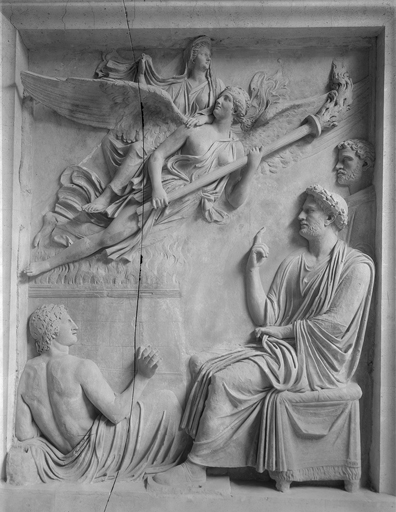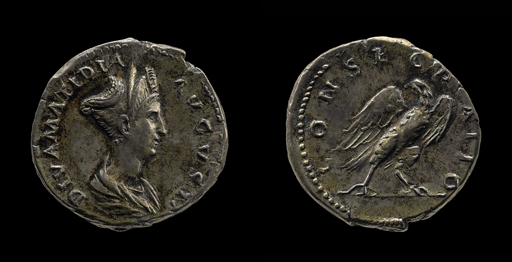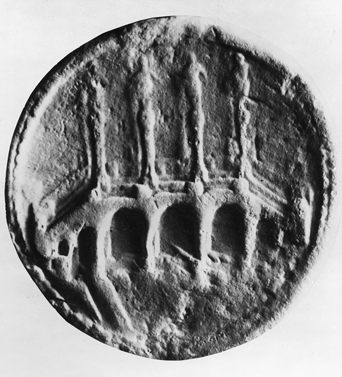3 Death, divinity and the emperor
One of the most prominent monuments on the skyline of modern Rome is the mausoleum of Hadrian, known today as the Castel Sant’Angelo. In this section we will investigate this impressive monument and assess its importance, but also think more widely about why commemoration after death mattered so much to emperors, and how this was linked to divine rights to rule.
Every new reign began with a death: that of the old emperor. In dynastic succession the new emperor derived his power and authority to rule from his predecessor, and thus it served him well to honour the dead emperor with a suitable burial and commemoration. In Rome there was the added incentive that the dead emperor might be given divine honours and be thought to reside among the gods. We have already seen the close relationship that Rome’s rulers and emperors forged with the gods, for example by dedicating and restoring temples. It was important that Rome’s rulers appeared to be pious and blessed by the gods, and some favoured certain deities, even claiming familial connections with them. At this stage it is important to note that the people of Rome did not subscribe to some sort of divine kingship. Although an emperor might cultivate a religious aura and close associations with deities, the living were not regarded as gods. Those who blurred the distinctions between the human and the divine, such as the emperor Domitian who, allegedly demanded to be called ‘Our Master and our God’ (Suetonius, Domitian 13.2), were seen as deluded and as bad rulers. However, at death it was possible for an emperor to be elevated to divine status.
The process of an emperor becoming a god is termed ‘apotheosis’. It involved elaborate funeral rites in which the spirit of the emperor was thought to fly heavenwards from the pyre (an eagle might be released to represent this ascent), but also a formal vote by the Senate confirming that the dead emperor had been consecrated as a god (Hekster, 2009; Price, 1987). Other members of the imperial family, including women, were sometimes granted divine honours, and this was to become increasingly the case in the second century CE. An emperor could thus find himself styled as the son of a god and have other relatives who were divine: these were no small accolades.
Hadrian was someone who seems to have been particularly aware of the significance of divinity. Like many of his predecessors, Hadrian favoured certain gods, promoting connections between himself and religion (see Section 2) as a sign that he was divinely sanctioned to rule, but the emperor also surrounded himself with gods of his own making. In this respect he is perhaps most famous for how he treated Antinous after his death. Antinous was a young man, a great favourite and a probable homosexual partner of Hadrian, who drowned in the Nile in mysterious circumstances in 130 CE (Dio Cassius 69.11.4; SHA, Hadrian 14.11). Hadrian seems to have promoted a cult of Antinous that became popular across the empire, and the emperor thought of Antinous as a god. However, Antinous was not formally deified in Rome by the Senate. He was not a member of the imperial family and his deification, though it may have been important to Hadrian, was informal. This stands in stark contrast to the treatment of members of Hadrian’s family: people through whom he derived and confirmed his right to rule.
In 117 CE the emperor Trajan died in Cilicia, in Asia Minor, and his successor, Hadrian, arranged for his remains to be returned to Rome accompanied by Plotina (Trajan’s wife), Matidia (Hadrian’s mother-in-law) and Attianus (the Praetorian Prefect) (SHA, Hadrian 5.9–10). His remains were placed in a golden urn (Eutropius 8.5.2.3) and interred in the base of Trajan’s Column (Dio Cassius 69.2.3), which still stands in Rome. The column is situated in Trajan’s Forum. It stands more than 44 metres high, on a base sculpted with weapons and trophies. On the shaft of the column is a spiralling narrative frieze, showing scenes from the Dacian Wars. A spiral staircase runs through the interior of the column and in antiquity would have given access to a viewing platform. Above this platform originally stood a statue of Trajan. It is unclear whether the column was built with the purpose of being Trajan’s tomb, or whether this decision was made later, or under Hadrian (Davies, 2000, p. 32). It has been suggested that the narrative reliefs, for which the column is famous, were added by Hadrian (Claridge, 1993). This is not a proposition accepted by all, but what we can say is that, under Hadrian, work continued on Trajan’s Forum and that Hadrian added, or completed, a temple to his now deified adoptive father (SHA, Hadrian 19.9), although the exact location of this is yet to be confirmed (Claridge, 2007).
In 119 CE Hadrian’s mother-in-law, Matidia, died. Her maternal uncle was the emperor Trajan. After the death of her father she was brought up in Trajan’s household. Matidia was also a second cousin to Hadrian and her daughter Sabina married him in 100 CE.
Activity 9
Look at Figure 16, a coin commemorating Matidia. Then read Primary Source 4, Hadrian’s speech on Matidia after her death.
This silver coin, issued during the reign of Hadrian, shows a bust of Matidia, facing right, with her hair worn up and wearing a diadem. The bust is encircled by the words DIVA AVGVSTA MATIDIA (‘the divine Augusta Matidia’). Augusta was the female equivalent of the name Augustus – and thus an honoured title for an emperor’s female relatives. On the reverse of the coin an eagle is depicted and the word CONSECRATIO (‘consecrated’) appears.
Study the coin, read the speech and, paying due attention to context, identify how Matidia was honoured after her death – and why.
Discussion
The role of the original inscription is unclear. But the coin, with its portrait of Matidia on one side and an eagle on the other, is clear evidence that Matidia was deified. The coin describes her as divine, while the eagle suggests her flight to the heavens (from the funeral pyre), and thereby verbally and visually declares her consecration as a goddess. Coins, with their images and texts, and their wide circulation, were often used to commemorate important events.
We do not know why the speech was recorded, or how and exactly where it was displayed. But the fact that it was recorded suggests that the speech was an important event, with its high praise for Matidia from the emperor, and possibly related to her consecration. According to the speech, Hadrian was fond of his mother-in-law. She was like a daughter to Trajan and a loyal wife to her husband. She was a modest woman who did not try to exploit her connections with powerful people. Hadrian was distressed at her decline and spoke of his grief at her death. The speech may have ended with a recommendation that Matidia be deified.
Hadrian might well have loved and respected his mother-in-law, but it undoubtedly was to his advantage to be seen to be honouring his Trajanic adopted family. Hadrian was now the son of a god (Trajan) and married to the daughter of a goddess, which all helped to legitimise his position. So as well as remembering Matidia, Hadrian was at the same time promoting an image of harmony and virtue within his own family, through his female relatives.
Hadrian also established a temple complex to Matidia and her mother Marciana (deified under Trajan) in the Campus Martius. Evidence for it is limited (Boatwright, 1987, pp. 58–62), but it was the first in Rome to be dedicated to a deified woman or women.
Trajan’s wife, Plotina, also appears to have been deified at her death in c.123 CE. Then in 136/7 CE Hadrian’s wife, Sabina, died and she too was deified. Hadrian erected a monumental altar in her honour, probably on the northern Campus Martius, to which a large marble relief panel may well have belonged.
Activity 10
Study the following sources (as you look at the images, make sure you read the descriptions below too):
- Primary Source 1: SHA, Hadrian 11 from ‘Septicius Clarus, prefect of the guard …’ to the end.
- Figure 17: relief panel depicting Sabina and Hadrian. This marble relief panel, now in the Museo del Palazzo dei Conservatori in Rome, is believed to have come from an altar dedicated to the deified Sabina. In the relief a winged female figure soars upwards, carrying Sabina on her back. A seated image of Hadrian, with a man standing in attendance, occupies the bottom right of the relief. To the bottom left is a semi-nude male figure, thought to be a personification of the Campus Martius, the area of Rome where the altar was located.
- Figure 19: coin commemorating Sabina. This silver coin, issued during the reign of Hadrian, shows a bust of Sabina, facing left, with her hair worn up, wearing a diadem, with the words SABINA AVGVSTA. On the reverse of the coin are the words CONCORDIA AVG(usta), and the figure of Concordia leaning on a column, holding a patera and two cornucopias. (Concordia was a Roman goddess who embodied harmony in marriage and society.)
How is the relationship between Sabina and Hadrian represented in these sources?

Discussion
According to the SHA, Hadrian and Sabina’s marriage was not a happy one. There were rumours of impropriety on Sabina’s part, and Hadrian found her ill-tempered and irritable. For his part Hadrian was a little too interested in other people’s lives, and far from faithful. All this may be little more than gossip, but if so it still became part of Hadrian’s legacy. Along with the other women of his household, Sabina does seem to have been important to Hadrian’s image. You may have noted in your earlier research that Hadrian and Sabina were childless, and this could have created anxieties about who would succeed the emperor. Nevertheless, the women of the imperial household provided connections to Hadrian’s predecessors and it was important for an emperor to promote an image of familial contentment (even if rumours suggested the contrary). Sabina appeared on the coinage during her lifetime and was styled Augusta. Her association with Concordia on the coin shown in Figure 18 promotes an image of harmony and well-being in the imperial family.
Sabina’s deification also suggests her importance. The relief panel shown in Figure 17 makes clear reference to her place among the gods, depicting her ascent to heaven from the funeral pyre, while foregrounding this deification in terms of her relationship to Hadrian. The emperor points heavenwards, bearing witness to her apotheosis, though notably his gaze, and that of his attendant, is not towards the heavens. Sabina soars upwards; Hadrian remains rooted to the ground. He is the son of a god and the husband of a goddess, but very much the living and human emperor.
The relief panel shown in Figure 17 powerfully suggests Sabina’s importance to the dynasty, but it is still notable that Hadrian is in the foreground and cast on a bigger scale; he, more than Sabina, dominates the panel. However, Penelope Davies has noted that when in its original, probably outdoor, location, with the overhead light source of the sun, the relief of Sabina may have ‘cast the empress into a celestial radiance appropriate for one experiencing apotheosis. Seen in this light, the balance of the scene changes: Hadrian is no longer the main focus, and the two imperial figures bear similar weight’ (Davies, 2000, p. 116). The importance of women in dynastic politics should not be underestimated, even if ultimately their imagery was promoted and manipulated by men.
Activity 11
Read the inscription from Hadrian’s mausoleum in Primary Source 5.
Is there anything that strikes you as unusual about its content?
Discussion
This inscription was set up by Hadrian’s successor, Antoninus Pius, on the completion of Hadrian’s mausoleum. The inscription is full of formal titles and powers that designate the authority of both emperors. But there are several things that you may have noticed about the content. The most striking is that although the mausoleum was commissioned by Hadrian, it is the name of Antoninus Pius which comes first in the inscription. The living emperor takes priority over the dead one. By contrast, Sabina’s name comes last in the inscription and is not associated with a long list of titles, yet she is styled divine. Hadrian is termed the son and grandson of gods, but he is not described as a god; nor is his adopted son and successor (Antoninus Pius) styled son of a god. You may recall from your earlier work that there was some delay in the deification of Hadrian. It seems likely that Antoninus Pius set up this inscription before Hadrian was deified, and thus in the inscription, despite being named last, the dead empress had higher status than the dead emperor.
Both Hadrian, then, and his successors were very aware of the importance of honouring their predecessors and creating a divine aura around the imperial family. Early in his reign Hadrian was already thinking about his own death and dynastic legacy. He began work on his mausoleum in the 120s CE, but at his death in 138 CE it may still have been incomplete. It is a monument with a long history, and was at one time used by the popes as a fort, prison and castle, making what now survives of the original structure often difficult to understand.
Activity 12
Go to the interactive map and click on the markers for the mausoleum of Augustus and the mausoleum of Hadrian.
What are the most striking similarities and differences between the two monuments?
Discussion
The most striking similarities between the two mausolea are their size, shape and location. Both are large-scale monumental structures planned by both emperors years before their deaths. Both mausolea are circular in shape. Both are located near the banks of the Tiber. And both had a major and lasting impact on the topography of Rome. There are differences between the two structures in the details of their execution that you may have identified. For example, the mausoleum of Hadrian sits on a square base, unlike Augustus’ mausoleum; and Hadrian’s mausoleum is integrated with a bridge across the Tiber, whereas Augustus’ mausoleum is integrated with the Augustan redevelopment of the Campus Martius.
Dio Cassius mentions that Hadrian began work on his tomb because the mausoleum of Augustus was full (Dio Cassius 69.23.1). Certainly Augustus’ mausoleum was in use for well over a century. Even if there were pragmatic factors in the decision to build a new imperial tomb, Hadrian was inspired by Augustus, while also wanting to outdo him. Augustus was the first Roman emperor and, someone who was greatly admired for the peace and stability he brought, and for how he rebuilt Rome. Later emperors often looked to Augustus as the emperor they most needed to emulate and surpass.
Activity 13
Turn to Reading 2. This is an extract from Penelope Davies’ book Death and the Emperor (2000).
Why did Hadrian place his mausoleum where he did? And how was it integrated into the topography of Rome?
Discussion
As Davies mentions, some scholars have been surprised at Hadrian’s choice of location for his mausoleum. The Ager Vaticanus was on the edge of town, the wrong side of the Tiber, with few religious or cultural associations and an area which produced wine of inferior quality. However, the emperors owned property here and it provided an unproblematic blank canvas, with the potential for something on a big enough scale to have a real impact. You may not have found Davies’ suggestion, that the Tiber was intended to evoke the River Styx, convincing. Is she overstating Hadrian’s interests in the underworld in this analogy? Did Augustus have similar thoughts when he placed his mausoleum near the Tiber? This aside, it is clear that Hadrian’s choice of site was not haphazard. It would have been highly visible at key traffic points, and having its own bridge increased access to this area. The mausoleum and the Pons Aelius should be seen as integrated. Due consideration was given to how the mausoleum fitted into the pre-Hadrianic and Hadrianic skyline, thereby weaving Hadrian into the cityscape of Rome. Hadrian was looking back to Augustus, but also creating connections with other structures that had a significance to his reign, such as Trajan’s Column and the Pantheon. There were, then, carefully ‘scripted views’ (p. 160) of Hadrian’s mausoleum, constructed to present a narrative of the dynasty and of Hadrian as a god in waiting.
In this section we have explored how Hadrian used death and divinity to promote himself. He exploited the deaths of others and anticipated his own death, all the time weaving a dynastic story around himself. His fascination with divinity may to us seem vain or egotistical. But it also reminds us that Roman traditions and culture, including those centred on religion, can be alien to us. Even if Hadrian was being self-serving and primarily thinking of his own posthumous divine status and reputation, by considering the dynasty he was also serving Rome and promoting stability. Arguably the best legacy an emperor could leave was a good successor, secure in his position, rather than a period of civil war and destruction. Hadrian may not have been the best emperor, but he succeeded in consolidating a dynasty, and thereby protected his monumental legacy too.




